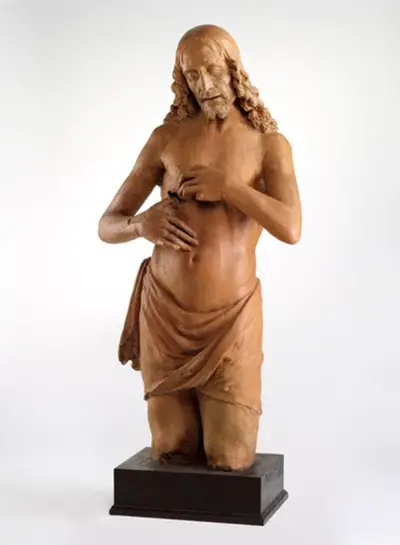Vir Dolorum is an original work of art by Andrea De Verrocchio who was Leonardo Da Vinci's and Sandro Botticelli mentor.
The original sculpture was first created by Verrocchio during the renaissance period in the year 1470 as a painted image. The original art shows Christ rising from the tomb with his side and hand prominently showing his wounds. Christ's image in the painting is shown as sorrowful and cut off at the waist. Also, the sorrowful but compassionate face is further enhanced by his closed eyes and his tilted head.
The artwork was detailed such as the long curly hair, the bleeding wounds, bearded face and the of Christ expression is clearly seen. The terracotta figure is a copy of the Verrocchio's original art. The physical dimensions of the art are 95 by 48 by 27 cm. The figure is sometimes referred to as man of sorrows and the image might have been inspired by the scripture's Isaiah 53 (servant songs).
Verrocchio's love for the sculpture was triggered by how the Romans during those days placed great value in statues and also he noted that the pope had a bronze horse erected in San Giovanni. The attention to detail that was given to the work impressed him and he, therefore, vowed to venture into sculptures such as Vir Dolorum. He, therefore, started working on his own unique technique.
Only Verrocchio was capable of producing the visually pleasing but sorrowful art of Dir Dolorum which was a highly realistic terracotta. In this type of work, Verrocchio came up with a renaissance classicism technique and also adapted some of the works of the great artists of that period. The technique was unique for that time and used widely all over Italy.
The compositional device employed during the painting allowed the hands and the face to express the mood and the character of Christ. In the art, we can also see how Verrocchio is specific on details and dynamically engaged. The technique employed by Verrocchio was unique and he took a lot of time to prepare before working on a sculpture. He took a great delight in the preparation stage, especially when making a cast. The cast that he used was from a soft stone that was quarried between the regions of Volterra and Siena or any other place in Italy.
He baked the stones in the fire and crushed them into a paste using tepid water. Crushing the stone into a paste made it possible to make anything from it. Once the paste dried up it became hard and therefore an artist could easily use it to cast a figure out of it. In order to make his work easier Verrocchio used to mould different parts of the human body such as the legs, hands, knees feet etc. before he could start working on a sculpture.
The material used by Verrocchio during the renaissance period was adapted and people started using them to make inexpensive death masks and different almost real figure on their windows, fireplaces etc. This practice continues until now. Actually the figures one sees while visiting Florence on several buildings are made from materials prepared in the same way as Verrocchio did. The Dir Dolorum was an image developed from epitaphios. In the 12th century, it was in possession of Santa Crore church which was located in Gerusalemme in Rome. The art is still owned by the Santa Crore Church. The art was commissioned by the Venetian Republic.




